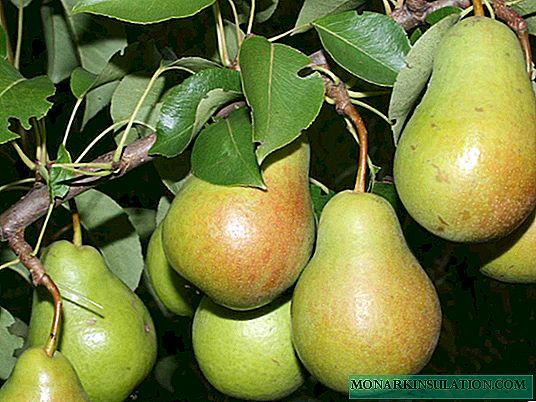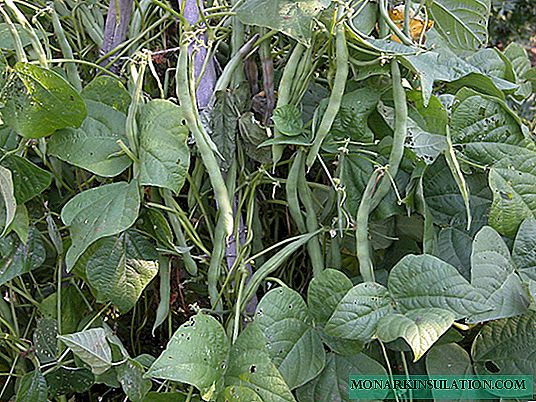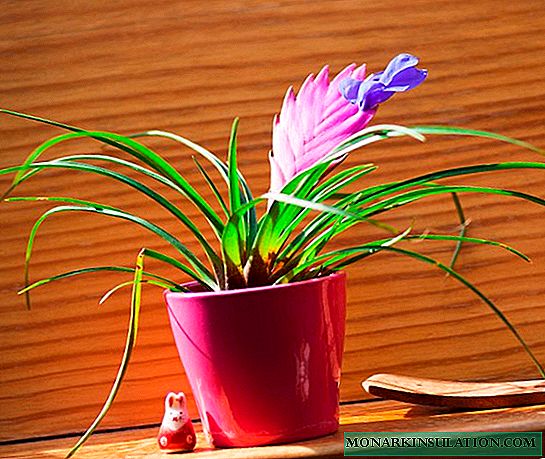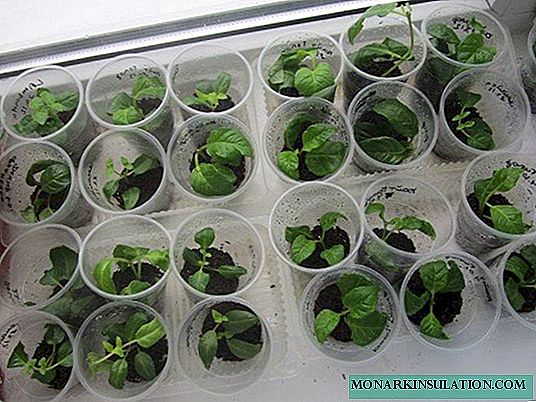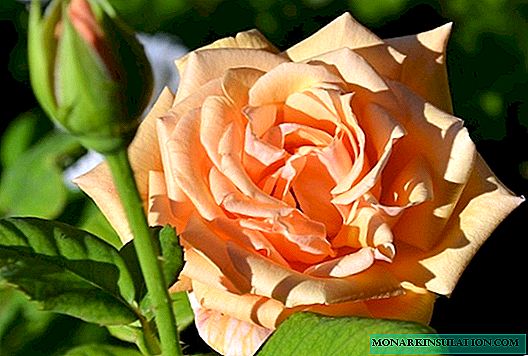A charming plant with white flowers and large green leaves is Spathiphyllum, also called "feminine happiness." It is very popular among florists due to the long flowering period, excellent decorative properties and unpretentious care.
Description
The homeland of spathiphyllum from the Aroid family is the tropical forests of Central and South America and some regions of Southeast Asia. The main species are common in Brazil, Colombia, Guyana, Trinidad, Venezuela, and the Philippines. A characteristic feature of the plant is a pearl-white leaf with a yellowish inflorescence in the form of an ears in the center.
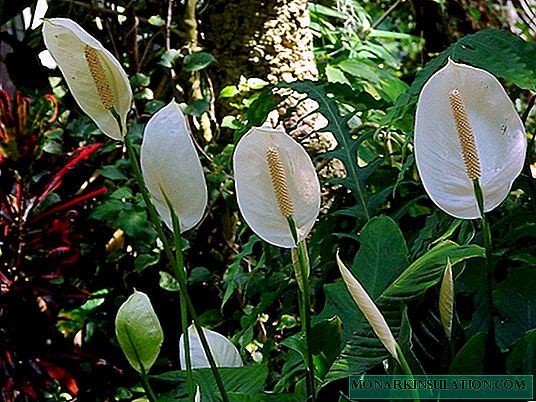
Spathiphyllum in the tropics
Large leaves have a rich dark green color and shine. The central strip and lateral veins noticeably stand out on them. In size, they reach up to 20 cm and are located on long petioles.
Bloom
If Spathiphyllum feels good, but not perfect, he will give many new leaves, but will not bloom. When flowering does not occur with good care throughout the year, you should think about a new place for the plant, the former may be too dark, despite the scattered light. The Russian sun simply does not have tropical power. In addition, the architecture of the building (small windows, etc.) can influence.
Important! The weak morning sun will not cause leaf burns, so it is possible to place a spathiphyllum flower in the morning under direct sunlight. This sometimes solves the problem.
Type and shape of flower
What appears to be a large flower petal in spathiphyllum, in fact, is not. This is a modified leaf, bract, which has acquired a white color during maturity. Over time, the bract turns slightly green. In different species of spathiphyllum, it may slightly differ in shape: to be more elongated, spoon-shaped, folded in the shape of a cone, etc. The inflorescence is the central ear of yellowish tones.

Spathiphyllum flower
Plant care during the flowering period is characterized by an active regime of watering and top dressing.
Common types and varieties
In total, there are about 50 plant species in the world. Most home varieties are hybrids derived from Spathipyhllum floribundum and Spathiphyllum wallisii. Hybrid varieties are more hardy and long-flowering. Some varieties of indoor spathiphyllum:
- Spathiphyllum Chopin. Its compactness and decorativeness provided the plant with wide popularity. The leaves are bright green, the bract is elongated, with a greenish tint;

Spathiphyllum Chopin
- Spathiphyllum Sensation. One of the largest species bred in Holland. Height - up to 1.5 m. Dimensions of dark green leaves: length - 70-90 cm, width - 30-40 cm. The length of inflorescences with bracts can reach 50 cm. Spad with a smooth surface. Better than other spathiphyllum tolerates dimming.

Spathiphyllum Sensation
Important! Signs of a lack of light - leaves turn pale, flowering stops.
- Dominoes Low decorative variety with variegated leaves (white strokes on a green background). Inflorescence of greenish or yellowish-white color. At night, the strong aroma disappears. Dimensions Domino average: height - 50-60 cm, sheet length - up to 20 cm, width - up to 10 cm;

Spathiphyllum Domino
- Picasso. This relatively new variety is also bred in the Netherlands based on Spathiphyllum wallisii. Green and white stripes randomly alternate on the leaves. For healthy growth requires good lighting;

Spathiphyllum Picasso
- Spathiphyllum floribundum. Plant height - up to 50 cm. Sizes of light green leaves with a wavy edge: length - 13-20 cm, width - 9.6 cm. Peduncle grows up to 25 cm. White bract: length - 4-8 cm, width - 1, 5-3 cm. The length of the cob is 2.5-5 cm. Abundant flowering almost all year. Cut flowers are stored in water for up to 2 months;

Spathiphyllum floribundum
Important! Spathiphyllum is moderately toxic. Calcium oxalate contained in the leaves can cause burns if it enters the mucous membranes and the respiratory tract.
- Mauna Loa. Large hybrid, whose height reaches almost 1 m. Bred by US breeders from Spathiphyllum Floribundum. Leaves with pointed tips, flowering continues almost throughout the year.
Healing properties
Spathiphyllum is considered one of the most useful plants for the home, due to its air-purifying properties. It absorbs volatile compounds of acetone, benzene, formaldehyde, trichloroethane from the air, is able to destroy mold, reduce colonies of harmful microorganisms. A high transpiration rate allows you to get rid of excessive dryness in the room.
Home Care Features
Spathiphyllum home care does not require particularly complicated, but without proper care the plant will not look so attractive.
Temperature
The optimum temperature range for Spathiphyllum is 18-25 ° C. In summer, the temperature in the room with the flower should be 20-25 ° C, in winter - 18-20 ° C. At temperatures below 14 ° C, the plant may die. When room temperature drops below 18 ° C, its growth slows down significantly.
Important! From cold, spathiphyllum develops diseases, leaves may begin to turn black.
Lighting
When caring for spathiphyllum, adequate lighting must be provided. In winter, the plant requires more light. In summer, it should be scattered, as direct sunlight can cause leaf burns.
Watering
A tropical plant loves good hydration. In summer, the irrigation regularity is 2-3 times a week. In this case, it is necessary to pay attention to the condition of the soil. Its top layer should dry, but moisture remains in the depths. Too plentiful watering is unacceptable. Water should not stagnate.

Watering spathiphyllum
Irrigation water is selected soft, room temperature. Rain water or well-maintained tap water will do.
Spraying
Watering the plants must be supplemented by spraying. In summer, this can be done daily. A warm shower is also useful, but be sure to keep water out of the bracts.
Important! Warm shower can be arranged only half an hour after watering. After the procedure, the frequency of spraying should be reduced. The plant becomes stronger, new leaves and flowers form on it.
Humidity
High humidity is a prerequisite for the good health of spathiphyllum. But it must be coordinated with air temperature. At low temperatures, humidity should be reduced, at high - increase.
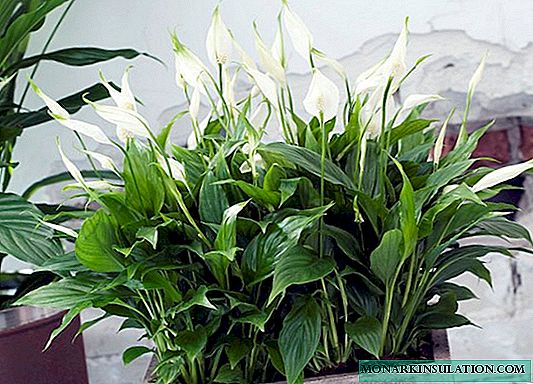
Lush bush in a flowerpot
In winter, it is recommended to keep the plant away from heating appliances. As an additional humidification of the air, water containers are placed next to the plant.
Priming
The flower does not tolerate stagnation of water or excessive drought. Therefore, at the bottom of the pot, good drainage should be organized, which will be suitable for pieces of polystyrene foam, pebbles, small ceramic fragments.
What soil is ideal for spathiphyllum? Light and loose, with a slightly acidic environment. You can buy ready-made soil for tropical or aroid plants, as well as compose yourself. To do this, take peat, leaf and turf land, humus, sand in equal parts.
Top dressing
The earth for spathiphyllum must be taken care of by feeding. This is a mandatory measure to ensure that the plant receives all the necessary trace elements.
The fertilizer must be liquid and contain potassium and phosphorus. It should be fed in the active period every two weeks. In winter, feeding stops or, if the room is warm enough, it is done no more than 1 time per month.
Key fertilizer recommendations:
- Feeding is effective on warm days and in bright rooms;
- Immediately after buying a plant, it is not recommended to fertilize it; it will take a couple of months to adapt;
- Newly transplanted flowers should not be fed;
- The fertilizer solution should not fall on the leaves of the plant;
- Before feeding, you should water the flower, which will prevent damage to the root system.
Important! You should make sure that nitrogen does not prevail in the composition of the fertilizer, otherwise the plant will stop flowering.
Winter care
There are a number of rules on how to care for spathiphyllum in winter. In winter, during dormancy, when the temperature drops to 16 ° C, frequent watering should be stopped. This happens once a year and lasts several weeks. A rest period with lower temperatures and less water is necessary for the plant.
Sometimes you can find recommendations to keep spathiphyllum for several weeks with reduced irrigation and not to fertilize. Then feed, start to water abundantly and more often to fertilize.

Lauretta variety
Presumably, this should stimulate flowering because such actions mimic tropical winters with less rain, followed by a moist, nutrient-rich spring. Such home care for a flower female happiness reproduces the natural living conditions of the plant, given the annual rhythm.
Pruning
The plant does not require pruning, except for the removal of dead leaves and flowers.
Breeding
The secret to success in the propagation of spathiphyllum depends on the choice of its method. The most time-consuming method, which also does not give a guarantee to grow a young individual, is to propagate using seeds. In total, three methods of reproduction are known:
- seed germination;
- division of the bush;
- rooting cuttings.
Seed germination
Important! The germination of spathiphyllum seeds is highly dependent on their freshness. When buying planting material, you should pay attention to the date of their collection.
Experienced gardeners prefer to collect seeds themselves, which increases the likelihood of germination. To obtain seeds, it is necessary to produce artificial pollination of flowers.
Procedure for germinating seeds:
- Pour steamed substrate from a mixture of sand and peat into the landing tank;
- The soil should be slightly moist. Seeds are sown and slightly pressed in or slightly sprinkled with soil on top;
- The container is covered with a film and placed in a warm place at a temperature of about 25 ° C. It is necessary to ensure that the soil does not dry out, periodically moistening it;
Important! The ground under the film should be ventilated daily.
- After the appearance of sprouts, the film is removed on the 5-7th day;
- When the sprouts threw the first leaves, they can be transplanted into separate pots.
Rooting cuttings
Young leaves sprout from the ground next to adult leaves. They will become cuttings if they are separated and pulled out of the soil. The separation is carried out with a sharp cutting tool, which is pre-disinfected. The movement of the knife should be quick and short.
Sometimes cuttings do not have roots. Then they are kept in water until the roots appear. Cuttings with roots need to be planted in the soil, previously heated in the oven. A drainage layer is laid at the bottom of the flower container.

Planting spathiphyllum cuttings
The pot with the plant is placed in a warm (temperature exceeds 21 ° C), slightly shaded place. One or two days after planting, you can only spray the sprout, then carefully proceed to watering, keeping the soil moist, but without excess water.
Bush division
It is the most successful method. With age, the plant forms a strong rhizome, which can be divided with a sharp knife. Each part must have at least 3 sheets forming a socket. Rotten roots are pruned.

Spathiphyllum rhizome division
Places of cuts are processed by coal. Separate parts are planted in pots and vigorously watered. They are not fertilized during the first three months of growth.
Important! To maintain the strength of the plant, it is advisable to divide it every 3-4 years, combining with transplants.
Transfer
Spathiphyllum blooms only when the pot is somewhat small. In a large pot, all his strength goes to the development of the root system. When it fills almost the entire volume, flower stalks are thrown. The young plant needs an annual transplant. In addition, each time the diameter of the pot should be 2-3 cm larger.
In adult spathiphyllum, the number of transplants is reduced to one in 3 years. Procedure time is spring, at the end of the dormant period and before flowering begins.

Spathiphyllum transplant
Step by Step Actions:
- Water the plant a little and carefully extract it from the old pot;
- Clear the roots with light movements. Rotten and very long - trim;
- In a new pot with a drainage layer and a small amount of soil, move the spathiphyllum, sprinkle on top with a substrate and press gently so that the flower sits tight;
- In the first days after transplantation, moderate watering and frequent spraying are recommended. Then normal care is restored.
Growing problems
Spathiphyllums are very hardy and relatively immune to pests. But they are poorly resistant to drafts and heavy smoke in the room. Characteristic signs of disease and treatment:
- The leaves turn pale. This comes from a lack of light. Need to increase the light;
- Discards leaves and buds. The pot is not cramped enough, there is little light, lack of fertilizer. Errors in the conditions of detention should be corrected;
- The tips dry on the leaves. Too dry air. Perhaps there are heating appliances nearby, then the flower is transferred to another place. It is also treated by frequent spraying;
- Brown spots on the surface of the leaves. This is a sign of excessive fertilizing. The plant needs a transplant;
- Why do they turn yellow or black, then the lower leaves fall? The reason is often excessive watering leading to root rot. The irrigation regime should be changed. Another reason is a lack of nutrients, the plant needs to be fed;

Damaged Spathiphyllum Leaves
- If the leaves partially darken and a spider web appears, the plant has been attacked by pests.
Most often, spathiphyllum is attacked by spider mites and aphids. It is necessary to carefully examine the leaves. If harmful insects are found, treat the plant with insecticides.
Signs and superstitions
Numerous signs are associated with spathiphyllum. Among his names are the spathiphyllum Feminine Happiness, Lily of the World, White Candle, White Sail.
It is believed that a flower can help:
- a lonely girl to find a groom;
- childless give birth to an heir;
- spouses achieve harmony and satisfaction in marriage.
If you give the flower to other hands, happiness will leave the house.
Interesting. The indigenous peoples of South America, the period of marriage rituals has long started with the beginning of flowering spathiphyllum.
Spathiphyllum looks great and places elegant accents in the design of the apartment. Growing it requires care, but not special knowledge and skills. Plants grown and sold in a nursery are preferable to buying than in a supermarket.

